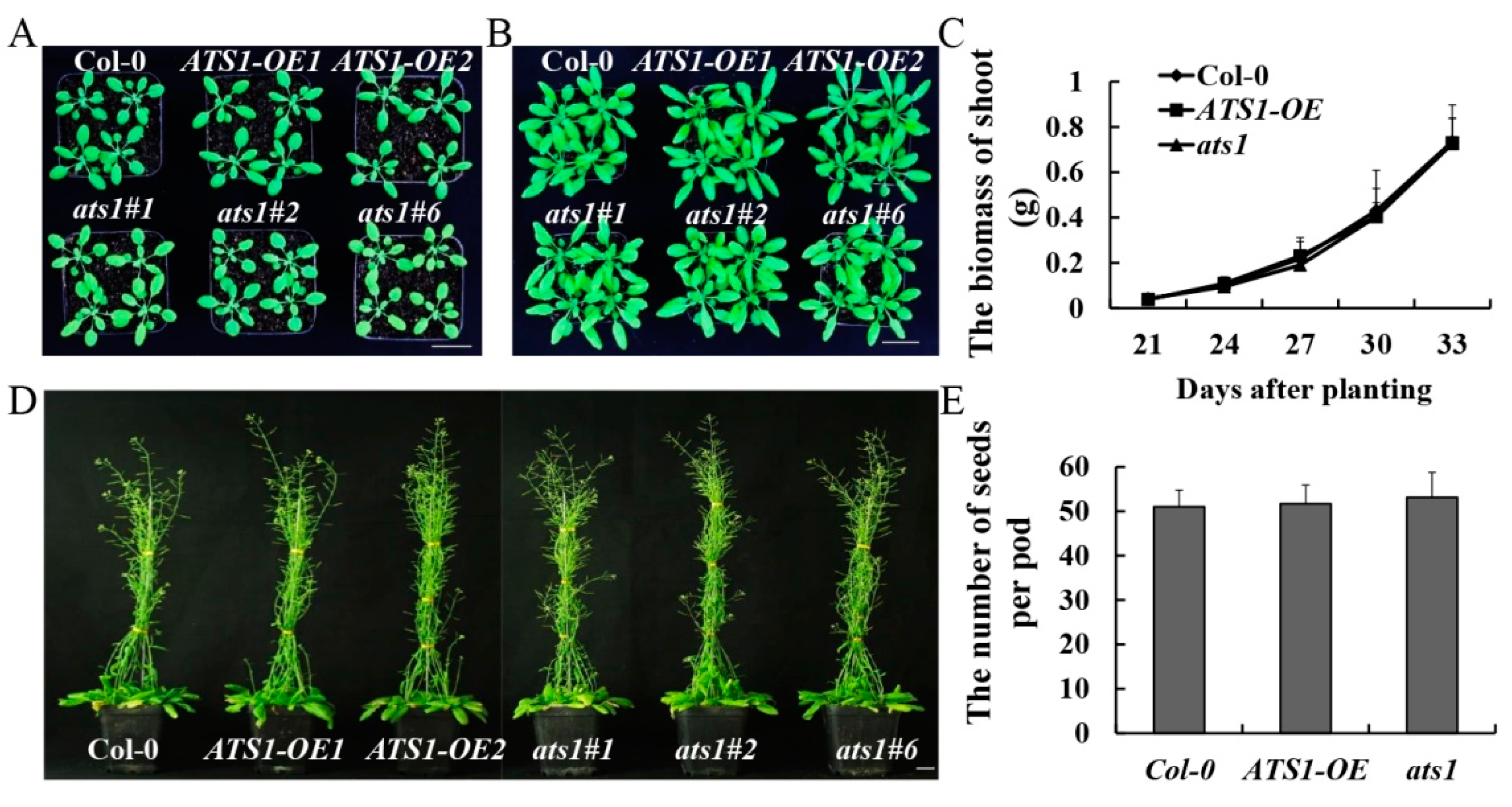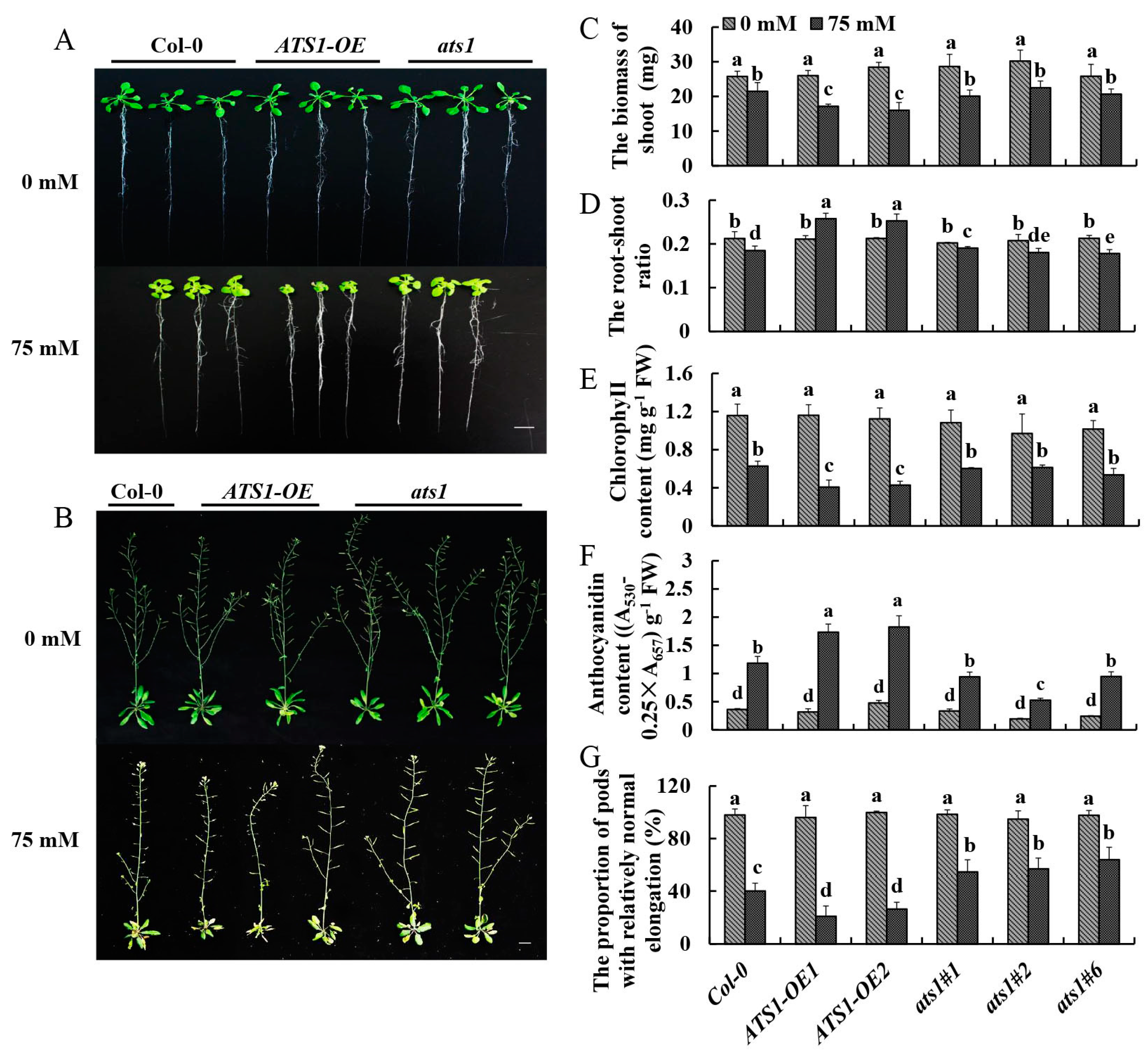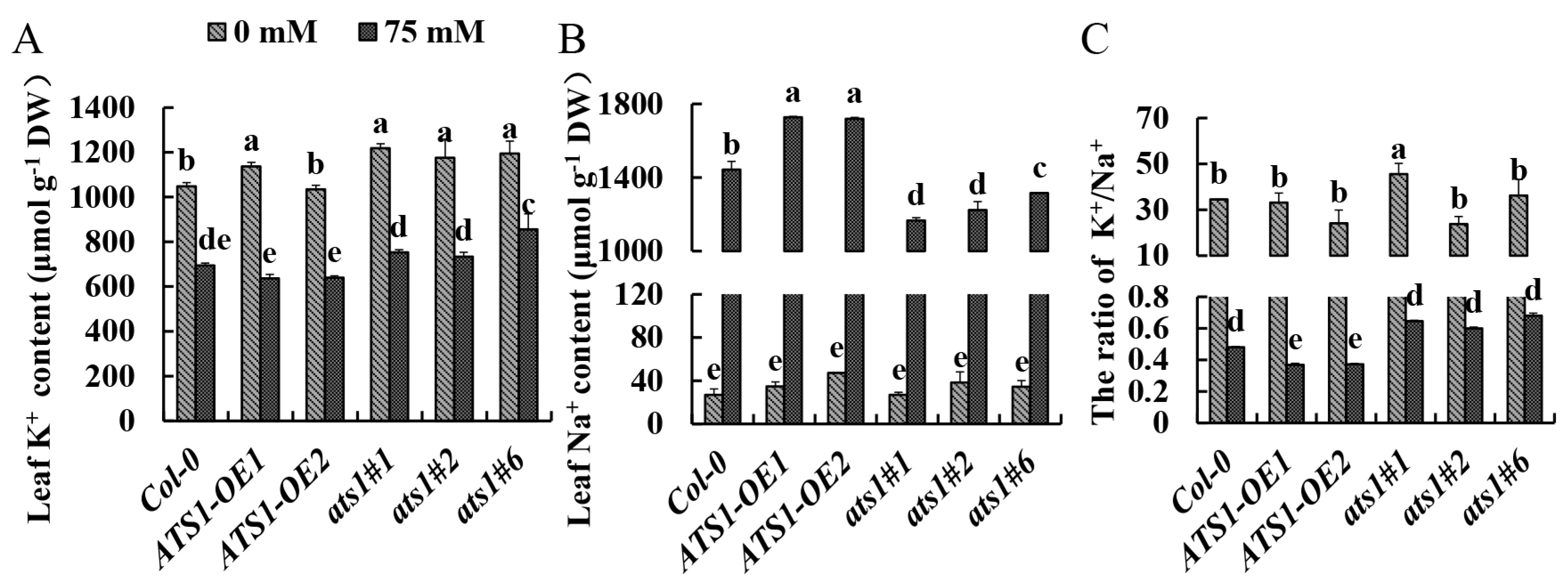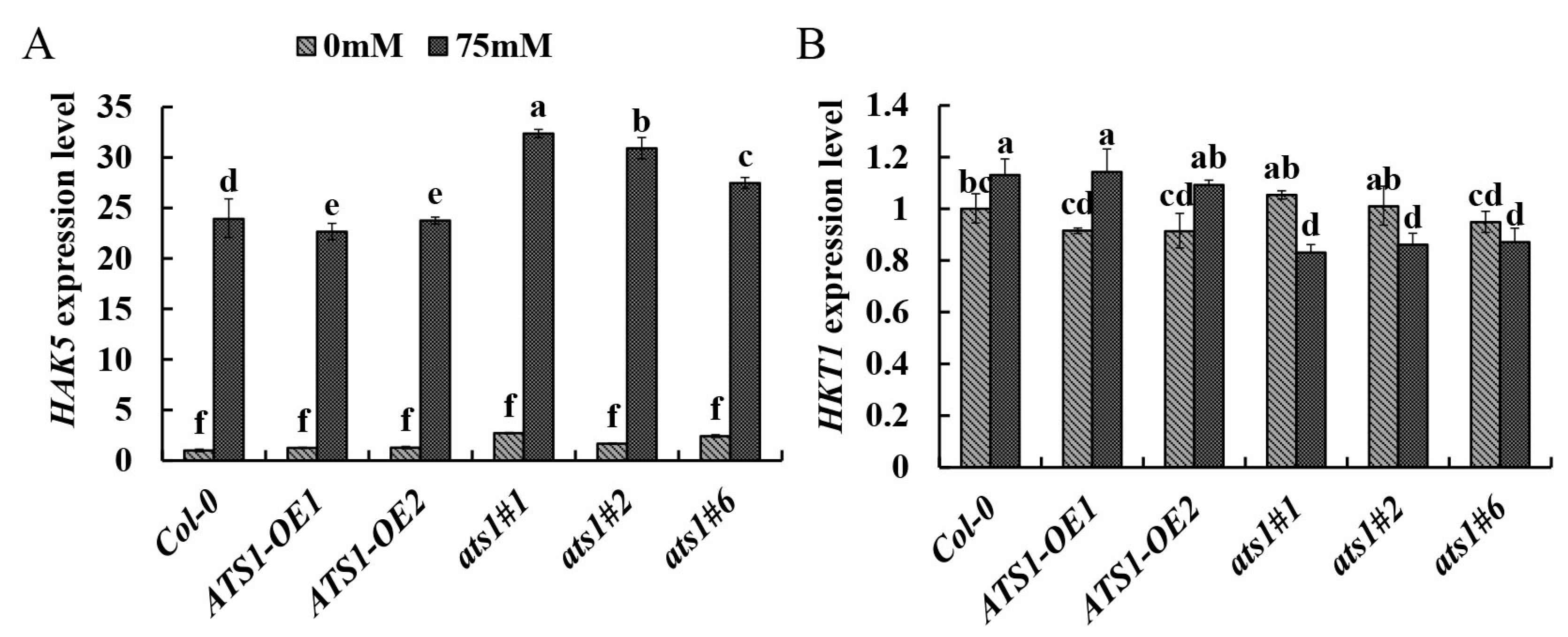Loss-of-Function of ATS1 Enhances Arabidopsis Salt Tolerance
Abstract
1. Introduction
2. Results
2.1. Overexpression and Mutation of ATS1 Produced No Visible Effect on Vegetative and Reproductive Growth of Arabidopsis thaliana under Normal Growth Conditions
2.2. Mutation of ATS1 Decreased Salt Sensitivity of Arabidopsis thaliana Seeds
2.3. Overexpression of ATS1 Reduced the Salt Tolerance of Arabidopsis thaliana
2.4. ats1 Mutants Had Increased Unsaturated Fatty Acid Content under Salt Stress
2.5. Overexpression Lines of ATS1 Were More Seriously Injured under Salt Stress
2.6. Mutation of ATS1 Maintained the Homeostasis of the K+/Na+ Ratio under Salt Stress
3. Discussion
4. Materials and Methods
4.1. Seed Sterilization
4.2. Plasmid Construction and Plant Transformation
4.3. Germination of Seeds and Growth Conditions
4.4. Determination of Chlorophyll and Anthocyanin Content
4.5. Determination of Fatty Acid Composition
4.6. Determination of Antioxidant Enzymes Activities and MDA Content
4.7. Determination of K+ and Na+ Content
4.8. Expression Analysis of Related Genes
4.9. Data Processing and Analysis
5. Conclusions
Author Contributions
Funding
Data Availability Statement
Acknowledgments
Conflicts of Interest
Appendix A
| Primer | Sequence (5′-3′) |
|---|---|
| AtHAK5-FP | TCTGCATCACTGGGACGGAG |
| AtHAK5-RP | CAGTATAACGGATCAGGGATTGA |
| AtHKT1-FP | CAAGTGGTGAATTCGCGACA |
| AtHKT1-RP | CATCATCTCCTCCTTCTTTCTCT |
| ATS1 PCR-FP | ATGACTCTCACGTTTTCCTC |
| ATS1 PCR-RP | CTAATTCCAAGGTTGTGACA |
| CAMV 35S promotor FP | TATGACCATGATTACGAATTCCATGGAGTCAAAGATTCAAA |
| CAMV 35S promotor RP | AAACGTGAGAGTCATAGTCCCCCGTGTTCTCTCCA |
| NOS terminator FP | CAACCTTGGAATTAGCGTTCAAACATTTGGCAATA |
| NOS terminator RP | GCCAAGCTTGCATGCCTGCAGCCCGATCTAGTAACATAGAT |
References
- Lei, G.; Zeng, W.; Jiang, Y.; Ao, C.; Wu, J.; Huang, J. Sensitivity analysis of the SWAP (Soil-Water-Atmosphere-Plant) model under different nitrogen applications and root distributions in saline soils. Pedosphere 2021, 31, 807–821. [Google Scholar] [CrossRef]
- Amini, S.; Ghadiri, H.; Chen, C.; Marschner, P. Salt-affected soils, reclamation, carbon dynamics, and biochar: A review. J. Soils Sediments 2016, 16, 939–953. [Google Scholar] [CrossRef]
- Behera, T.K.; Krishna, R.; Ansari, W.A.; Aamir, M.; Kumar, P.; Kashyap, S.P.; Pandey, S.; Kole, C. Approaches involved in the vegetable crops salt stress tolerance improvement: Present status and way ahead. Front. Plant Sci. 2021, 12, 787292. [Google Scholar] [CrossRef] [PubMed]
- Munns, R. Genes and salt tolerance: Bringing them together. New Phytol. 2005, 167, 645–663. [Google Scholar] [CrossRef] [PubMed]
- Wani, S.H.; Kumar, V.; Khare, T.; Guddimalli, R.; Parveda, M.; Solymosi, K.; Suprasanna, P.; Kavi Kishor, P.B. Engineering salinity tolerance in plants: Progress and prospects. Planta 2020, 251, 76. [Google Scholar] [CrossRef]
- Zhao, S.; Zhang, Q.; Liu, M.; Zhou, H.; Ma, C.; Wang, P. Regulation of plant responses to salt stress. Int. J. Mol. Sci. 2021, 22, 4609. [Google Scholar] [CrossRef] [PubMed]
- Rawat, N.; Singla-Pareek, S.L.; Pareek, A. Membrane dynamics during individual and combined abiotic stresses in plants and tools to study the same. Physiol. Plant. 2021, 171, 653–676. [Google Scholar] [CrossRef]
- Guo, Q.; Liu, L.; Barkla, B.J. Membrane lipid remodeling in response to salinity. Int. J. Mol. Sci. 2019, 20, 4264. [Google Scholar] [CrossRef] [PubMed]
- Watson, H. Biological membranes. Essays Biochem. 2015, 59, 43–69. [Google Scholar] [CrossRef] [PubMed]
- Sui, N.; Tian, S.S.; Wang, W.Q.; Wang, M.J.; Fan, H. Overexpression of glycerol-3-phosphate acyltransferase from Suaeda salsa improves salt tolerance in Arabidopsis. Front. Plant Sci. 2017, 8, 1337. [Google Scholar] [CrossRef]
- Dakhma, W.S.; Zarrouk, M.; Cherif, A. Effects of drought-stress on lipids in rape leaves. Phytochemistry 1995, 40, 1383–1386. [Google Scholar] [CrossRef]
- Olsson, M. Alterations in lipid composition, lipid peroxidation and anti-oxidative protection during senescence in drought stressed plants and non-drought stressed plants of pisum sativum. Plant Physiol. Biochem. 1995, 33, 547–553. [Google Scholar]
- Matos, M.C.; Campos, P.S.; Ramalho, J.C.; Marques, N.M.; Matos, A. Photosynthetic activity and cellular integrity of the andean legume Pachyrhizus ahipa (Wedd.) parodi under heat and water stress. Photosynthetica 2002, 40, 493–501. [Google Scholar] [CrossRef]
- Liu, X.Y.; Li, B.; Yang, J.H.; Sui, N.; Yang, X.M.; Meng, Q.W. Overexpression of tomato chloroplast omega-3 fatty acid desaturase gene alleviates the photoinhibition of photosystems 2 and 1 under chilling stress. Photosynthetica 2008, 46, 185–192. [Google Scholar] [CrossRef]
- Sui, N.; Han, G. Salt-induced photoinhibition of PSII is alleviated in halophyte Thellungiella halophila by increases of unsaturated fatty acids in membrane lipids. Acta Physiol. Plant. 2014, 36, 983–992. [Google Scholar] [CrossRef]
- Chen, X.; Snyder, C.L.; Truksa, M.; Shah, S.; Weselake, R.J. sn-Glycerol-3-phosphate acyltransferases in plants. Plant Signal. Behav. 2011, 6, 1695–1699. [Google Scholar] [CrossRef]
- Payá-Milans, M.; Aznar-Moreno, J.A.; Balbuena, T.S.; Haslam, R.P.; Gidda, S.K.; Pérez-Hormaeche, J.; Mullen, R.T.; Thelen, J.J.; Napier, J.A.; Salas, J.J.; et al. Sunflower HaGPAT9-1 is the predominant GPAT during seed development. Plant Sci. 2016, 252, 42–52. [Google Scholar] [CrossRef]
- Kang, H.; Jia, C.; Liu, N.; Aboagla, A.A.A.; Chen, W.; Gong, W.; Tang, S.; Hong, Y. Plastid glycerol-3-phosphate acyltransferase enhanced plant growth and prokaryotic glycerolipid synthesis in Brassica napus. Int. J. Mol. Sci. 2020, 21, 5325. [Google Scholar] [CrossRef] [PubMed]
- Nishida, I.; Sugiura, M.; Enju, A.; Nakamura, M. A second gene for acyl-(acyl-carrier-protein): Glycerol-3-phosphate acyltransferase in squash, Cucurbita moschata cv. Shirogikuza(*), codes for an oleate-selective isozyme: Molecular cloning and protein purification studies. Plant Cell Physiol. 2000, 41, 1381–1391. [Google Scholar] [CrossRef] [PubMed]
- Bhella, R.S.; MacKenzie, S.L. Nucleotide sequence of a cDNA from Carthamus tinctorius encoding a glycerol-3-phosphate acyl transferase. Plant Physiol. 1994, 106, 1713–1714. [Google Scholar] [CrossRef]
- Payá-Milans, M.; Venegas-Calerón, M.; Salas, J.J.; Garcés, R.; Martínez-Force, E. Cloning, heterologous expression and biochemical characterization of plastidial sn-glycerol-3-phosphate acyltransferase from Helianthus annuus. Phytochemistry 2015, 111, 27–36. [Google Scholar] [CrossRef]
- Misra, A.; Khan, K.; Niranjan, A.; Kumar, V.; Sane, V.A. Heterologous expression of two GPATs from Jatropha curcas alters seed oil levels in transgenic Arabidopsis thaliana. Plant Sci. 2017, 263, 79–88. [Google Scholar] [CrossRef]
- Kunst, L.; Browse, J.; Somerville, C. Altered regulation of lipid biosynthesis in a mutant of Arabidopsis deficient in chloroplast glycerol-3-phosphate acyltransferase activity. Proc. Natl. Acad. Sci. USA 1988, 85, 4143–4147. [Google Scholar] [CrossRef] [PubMed]
- Murata, N.; Ishizaki-Nishizawa, O.; Higashi, S.; Hayashi, H.; Tasaka, Y.; Nishida, I. Genetically engineered alteration in the chilling sensitivity of plants. Nature 1992, 356, 710–713. [Google Scholar] [CrossRef]
- Sun, Y.L.; Li, F.; Su, N.; Sun, X.L.; Zhao, S.J.; Meng, Q.W. The increase in unsaturation of fatty acids of phosphatidylglycerol in thylakoid membrane enhanced salt tolerance in tomato. Photosynthetica 2010, 48, 400–408. [Google Scholar] [CrossRef]
- Ke, X.X.; Liu, Y.K.; Xu, X.Z.; Lin, Y.X.; Zheng, Z.F.; Zheng, Y.P. Loss-of-function mutations in ATS1 reveal its dispensable role in normal seed development of Arabidopsis. J. Zhejiang A&F Univ. 2023, 40, 707–713. [Google Scholar]
- Hajihashemi, S.; Skalicky, M.; Brestic, M.; Pavla, V. Cross-talk between nitric oxide, hydrogen peroxide and calcium in salt-stressed Chenopodium quinoa Willd. At seed germination stage. Plant Physiol. Biochem. 2020, 154, 657–664. [Google Scholar] [CrossRef] [PubMed]
- Ibrahim, E.A. Seed priming to alleviate salinity stress in germinating seeds. J. Plant Physiol. 2016, 192, 38–46. [Google Scholar] [CrossRef]
- Bláha, L. Importance of root—Shoot ratio for crops roduction. J. Agron. Agric. Sci. 2019, 2, 12. [Google Scholar]
- Fleischer, W.E. The relation between chlorophyll content and rate of photosynthesis. J. Gen. Physiol. 1935, 18, 573–597. [Google Scholar] [CrossRef]
- Huot, B.; Yao, J.; Montgomery, B.L.; He, S.Y. Growth–defense tradeoffs in plants: A balancing act to optimize fitness. Mol. Plant 2014, 7, 1267–1287. [Google Scholar] [CrossRef]
- Huang, J.; Xue, C.; Wang, H.; Wang, L.; Schmidt, W.; Shen, R.; Lan, P. Genes of ACYL CARRIER PROTEIN family show different expression profiles and overexpression of ACYL CARRIER PROTEIN 5 modulates fatty acid composition and enhances salt stress tolerance in Arabidopsis. Front. Plant Sci. 2017, 8, 987. [Google Scholar] [CrossRef]
- Mikami, K.; Murata, N. Membrane fluidity and the perception of environmental signals in cyanobacteria and plants. Prog. Lipid Res. 2003, 42, 527–543. [Google Scholar] [CrossRef] [PubMed]
- Wang, J.; Chen, G.; Zhang, C. The effects of water stress on soluble protein content, the activity of SOD, POD and CAT of two ecotypes of reeds (Phragmites communis). Acta Bot. Bras. 2002, 22, 561–565. [Google Scholar]
- Wang, C.T.; Ru, J.N.; Liu, Y.W.; Li, M.; Zhao, D.; Yang, J.F.; Fu, J.D.; Xu, Z.S. Maize WRKY transcription factor ZmWRKY106 confers drought and heat tolerance in transgenic plants. Int. J. Mol. Sci. 2018, 19, 3046. [Google Scholar] [CrossRef] [PubMed]
- Baxter, A.; Mittler, R.; Suzuki, N. ROS as key players in plant stress signalling. J. Exp. Bot. 2014, 65, 1229–1240. [Google Scholar] [CrossRef]
- Ashley, M.K.; Grant, M.; Grabov, A. Plant responses to potassium deficiencies: A role for potassium transport proteins. J. Exp. Bot. 2006, 57, 425–436. [Google Scholar] [CrossRef]
- Shabala, S.; Pottosin, I. Regulation of potassium transport in plants under hostile conditions: Implications for abiotic and biotic stress tolerance. Physiol. Plant. 2014, 151, 257–279. [Google Scholar] [CrossRef]
- Lara, A.; Ródenas, R.; Andrés, Z.; Martínez, V.; Quintero, F.J.; Nieves-Cordones, M.; Botella, M.A.; Rubio, F. Arabidopsis K+ transporter HAK5-mediated high-affinity root K+ uptake is regulated by protein kinases CIPK1 and CIPK9. J. Exp. Bot. 2020, 71, 5053–5060. [Google Scholar] [CrossRef]
- Ali, A.; Maggio, A.; Bressan, R.A.; Yun, D.J. Role and functional differences of HKT1-type transporters in plants under salt stress. Int. J. Mol. Sci. 2019, 20, 1059. [Google Scholar] [CrossRef]
- Kunst, L.; Browse, J.; Somerville, C. Altered chloroplast structure and function in a mutant of Arabidopsis deficient in plastid glycerol-3-phosphate acyltransferase activity. Plant Physiol. 1989, 90, 846–853. [Google Scholar] [CrossRef] [PubMed]
- Xu, C.; Yu, B.; Cornish, A.J.; Froehlich, J.E.; Benning, C. Phosphatidylglycerol biosynthesis in chloroplasts of Arabidopsis mutants deficient in acyl-ACP glycerol-3- phosphate acyltransferase. Plant J. 2006, 47, 296–309. [Google Scholar] [CrossRef] [PubMed]
- Xue, M.; Guo, T.; Ren, M.; Wang, Z.; Tang, K.; Zhang, W.; Wang, M. Constitutive expression of chloroplast glycerol 3-phosphate acyltransferase from Ammopiptanthus mongolicus enhances unsaturation of chloroplast lipids and tolerance to chilling, freezing and oxidative stress in transgenic Arabidopsis. Plant Physiol. Biochem. 2019, 143, 375–387. [Google Scholar] [CrossRef]
- Sui, N.; Li, M.; Zhao, S.J.; Li, F.; Liang, H.; Meng, Q.W. Overexpression of glycerol-3-phosphate acyltransferase gene improves chilling tolerance in tomato. Planta 2007, 226, 1097–1108. [Google Scholar] [CrossRef] [PubMed]
- Assaha, D.V.M.; Ueda, A.; Saneoka, H.; Al-Yahyai, R.; Yaish, M.W. The role of Na+ and K+ transporters in salt stress adaptation in glycophytes. Front. Physiol. 2017, 8, 509. [Google Scholar] [CrossRef]
- Shi, H.; Lee, B.H.; Wu, S.J.; Zhu, J.K. Overexpression of a plasma membrane Na+/H+ antiporter gene improves salt tolerance in Arabidopsis thaliana. Nat. Biotechnol. 2003, 21, 81–85. [Google Scholar] [CrossRef]
- Zhang, Q.; Xiao, S.Y. Lipids in salicylic acid-mediated defense in plants: Focusing on the roles of phosphatidic acid and phosphatidylinositol 4-phosphate. Front. Plant Sci. 2015, 6, 387. [Google Scholar] [CrossRef]
- Wang, Q.; Ni, J.; Shah, F.; Liu, W.; Wang, D.; Yao, Y.; Hu, H.; Huang, S.; Hou, J.; Fu, S.; et al. Overexpression of the stress-inducible SsMAX2 promotes drought and salt resistance via the regulation of redox homeostasis in Arabidopsis. Int. J. Mol. Sci. 2019, 20, 837. [Google Scholar] [CrossRef]
- Li, D.D.; Lin, R.; Li, X.; Zheng, Y.P. Functional analysis of AtJAR1 gene in salt tolerance of Arabidopsis thaliana. J. Zhejiang A&F Univ. 2022, 39, 998–1009. [Google Scholar]
- Xie, Y.; Tan, H.; Ma, Z.; Huang, J. DELLA Proteins Promote Anthocyanin Biosynthesis via Sequestering MYBL2 and JAZ Suppressors of the MYB/bHLH/WD40 Complex in Arabidopsis thaliana. Mol. Plant 2016, 9, 711–721. [Google Scholar] [CrossRef]
- Cahoon, E.B.; Marillia, E.F.; Stecca, K.L.; Hall, S.E.; Taylor, D.C.; Kinney, A.J. Production of fatty acid components of meadowfoam oil in somatic soybean embryos. Plant Physiol. 2000, 124, 243–251. [Google Scholar] [CrossRef] [PubMed]
- Constantine, N.G.; Ries, S.K. Superoxide dismutases: I. Occurrence in higher plants. Plant Physiol. 1977, 59, 309–314. [Google Scholar]
- He, X.; Gao, S. Changes of Antioxidant enzyme and phenylalanine ammonia-lyase activities during Chimonanthus praecox seed maturation. Z. Naturforschung C J. Biosci. 2008, 63, 569–573. [Google Scholar] [CrossRef] [PubMed]
- Landi, M. Commentary to: “Improving the thiobarbituric acid-reactive-substances assay for estimating lipid peroxidation in plant tissues containing anthocyanin and other interfering compounds” by Hodges et al., Planta 1999, 207, 604–611. Planta 2017, 245, 1067. [Google Scholar] [CrossRef] [PubMed]
- Bose, J.; Xie, Y.; Shen, W.; Shabala, S. Haem oxygenase modifies salinity tolerance in Arabidopsis by controlling K+ retention via regulation of the plasma membrane H+-ATPase and by altering SOS1 transcript levels in roots. J. Exp Bot. 2013, 64, 471–481. [Google Scholar] [CrossRef] [PubMed]






| Fatty Acid Composition | Col-0 | ATS1-OE1 | ATS1-OE2 | ats1#1 | ats1#2 | ats1#6 |
|---|---|---|---|---|---|---|
| C14:0 | 0.50 ± 0.03 | 0.52 ± 0.05 | 0.56 ± 0.07 | 0.49 ± 0.05 | 0.48 ± 0.03 | 0.48 ± 0.08 |
| C14:1 | 1.27 ± 0.05 | 1.22 ± 0.11 | 1.43 ± 0.13 | 1.23 ± 0.21 | 1.26 ± 0.21 | 1.32 ± 0.16 |
| C16:0 | 18.37 ± 0.2 | 21.38 ± 2.42 | 21.20 ± 0.56 | 17.91 ± 1.24 | 16.78 ± 1.24 | 16.21 ± 0.99 |
| C16:1 | 3.28 ± 0.1 | 3.74 ± 0.2 | 3.66 ± 0.1 | 2.37 ± 0.12 | 2.49 ± 0.12 | 2.49 ± 0.08 |
| C16:3 | 10.85 ± 0.2 | 12.91 ± 027 | 12.02 ± 0.18 | 0.86 ± 0.03 | 0.63 ± 0.03 | 0.67 ± 0.12 |
| C18:0 | 1.97 ± 0.11 | 3.42 ± 0.3 | 2.94 ± 0.53 | 2.51 ± 0.43 | 2.84 ± 0.43 | 2.56 ± 0.53 |
| C18:1cis | 3.63 ± 0.2 | 3.30 ± 0.15 | 3.33 ± 0.2 | 8.29 ± 0.15 | 8.06 ± 0.15 | 8.09 ± 0.14 |
| C18:2cis | 16.19 ± 0.23 | 13.89 ± 0.8 | 15.24 ± 0.36 | 18.90 ± 0.73 | 18.73 ± 0.73 | 18.92 ± 0.67 |
| C18:3n3 | 43.50 ± 0.13 | 39.75 ± 2.3 | 39.83 ± 0.82 | 47.81 ± 1.6 | 48.41 ± 1.6 | 48.79 ± 1.86 |
| Saturated fatty acid | 20.82 ± 0.26 | 21.34 ± 0.75 | 21.51 ± 0.9 | 21.18 ± 0.68 | 21.34 ± 0.42 | 20.34 ± 0.92 |
| Unsaturated fatty acid | 79.18 ± 0.26 | 78.66 ± 0.75 | 78.49 ± 0.9 | 78.82 ± 0.68 | 78.66 ± 0.42 | 79.66 ± 0.92 |
| Fatty Acid Composition | Col-0 | ATS1-OE1 | ATS1-OE2 | ats1#1 | ats1#2 | ats1#6 |
|---|---|---|---|---|---|---|
| C14:0 | 0.57 ± 0.05 | 0.50 ± 0.03 | 0.51 ± 0.02 | 0.62 ± 0.11 | 0.74 ± 0.1 | 0.68 ± 0.05 |
| C14:1 | 1.52 ± 0.19 | 1.40 ± 0.09 | 1.44 ± 0.12 | 1.36 ± 0.19 | 1.66 ± 0.14 | 1.47 ± 0.09 |
| C16:0 | 21.54 ± 1.25 | 20.81 ± 0.24 | 21.41 ± 0.83 | 17.43 ± 1.37 | 15.30 ± 1.07 | 14.13 ± 0.57 |
| C16:1 | 3.19 ± 0.1 | 3.52 ± 0.04 | 3.57 ± 0.11 | 2.73 ± 0.26 | 2.40 ± 0.11 | 2.41 ± 0.1 |
| C16:3 | 10.19 ± 0.55 | 12.42 ± 0.16 | 11.72 ± 0.28 | 0.86 ± 0.07 | 0.55 ± 0.04 | 0.52 ± 0.02 |
| C18:0 | 3.67 ± 1.16 | 2.07 ± 0.1 | 2.95 ± 0.33 | 3.96 ± 0.91 | 4.01 ± 1.07 | 2.79 ± 0.14 |
| C18:1cis | 2.84 ± 0.08 | 2.81 ± 0.08 | 2.92 ± 0.27 | 5.58 ± 0.17 | 6.74 ± 0.16 | 7.02 ± 0.14 |
| C18:2cis | 15.46 ± 0.77 | 13.56 ± 0.13 | 14.48 ± 0.68 | 20.85 ± 0.8 | 20.56 ± 0.61 | 20.50 ± 0.33 |
| C18:3n3 | 43.09 ± 2.61 | 42.91 ± 0.18 | 41.50 ± 0.71 | 46.42 ± 0.31 | 48.86 ± 0.53 | 50.58 ± 0.74 |
| Saturated fatty acid | 25.95 ± 1.15 a | 23.38 ± 0.2 b | 25.06 ± 1.27 a | 17.72 ± 0.93 c | 18.85 ± 0.63 c | 17.49 ± 0.63 c |
| Unsaturated fatty acid | 74.05 ± 1.15 c | 76.62 ± 0.2 b | 74.94 ± 1.27 c | 82.28 ± 0.93 a | 81.15 ± 0.63 a | 82.51 ± 0.63 a |
Disclaimer/Publisher’s Note: The statements, opinions and data contained in all publications are solely those of the individual author(s) and contributor(s) and not of MDPI and/or the editor(s). MDPI and/or the editor(s) disclaim responsibility for any injury to people or property resulting from any ideas, methods, instructions or products referred to in the content. |
© 2023 by the authors. Licensee MDPI, Basel, Switzerland. This article is an open access article distributed under the terms and conditions of the Creative Commons Attribution (CC BY) license (https://creativecommons.org/licenses/by/4.0/).
Share and Cite
Liu, Y.; Wu, G.; Ke, X.; Zheng, Z.; Zheng, Y. Loss-of-Function of ATS1 Enhances Arabidopsis Salt Tolerance. Plants 2023, 12, 2646. https://doi.org/10.3390/plants12142646
Liu Y, Wu G, Ke X, Zheng Z, Zheng Y. Loss-of-Function of ATS1 Enhances Arabidopsis Salt Tolerance. Plants. 2023; 12(14):2646. https://doi.org/10.3390/plants12142646
Chicago/Turabian StyleLiu, Yakun, Guifen Wu, Xingxing Ke, Zhifu Zheng, and Yueping Zheng. 2023. "Loss-of-Function of ATS1 Enhances Arabidopsis Salt Tolerance" Plants 12, no. 14: 2646. https://doi.org/10.3390/plants12142646
APA StyleLiu, Y., Wu, G., Ke, X., Zheng, Z., & Zheng, Y. (2023). Loss-of-Function of ATS1 Enhances Arabidopsis Salt Tolerance. Plants, 12(14), 2646. https://doi.org/10.3390/plants12142646






